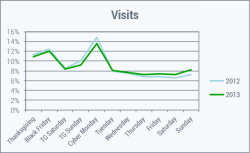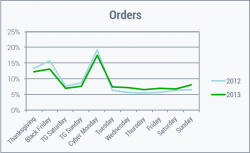As a data-driven company that derives relevant shopping insights from the billions of shopping sessions we touch each year, we wanted to assemble a series of interesting take-aways that showcase notable trends of the all-important holiday shopping season.
Just as the holiday season is about feelings as much as shopping, per se, so too holiday data can be seen for the picture it paints about where we find ourselves as 2013 draws to a close. Anthropologists have always understood that shopping, giving, and exchanges of goods say much about a culture. While our specialities are computer science, engineering, and marketing, we invariably find what data can tell us very interesting … and we hope you will, too.
Please join us as we explore the trends we’re seeing during this December, starting with this first nugget:
Seasonal Shopping Insight #1
Shoppers Less Responsive to Retailers’ Day-Specific Promotions though Cyber Monday Gains Ground
 US consumers appear to be spreading out their online shopping visits and spending over the entire holiday period, rather than concentrating their activity on key days such as Black Friday and Cyber Monday—perhaps to the consternation of retailers who devote massive marketing effort to lure shoppers in-store and online on select days. (See a related story in Internet Retailer, which used our data to discuss mobile e-commerce trends over the start of the holiday season.)
US consumers appear to be spreading out their online shopping visits and spending over the entire holiday period, rather than concentrating their activity on key days such as Black Friday and Cyber Monday—perhaps to the consternation of retailers who devote massive marketing effort to lure shoppers in-store and online on select days. (See a related story in Internet Retailer, which used our data to discuss mobile e-commerce trends over the start of the holiday season.)
We reviewed comparable sites, year-over-year, examining the share of revenue, orders, visits, and other key metrics over the 11-day period from Thanksgiving through Sunday, Dec 8 (using comparable days for 2012).
On the plus side:
- Conversion rates are higher this year, especially in the post-Cyber Monday period.
- Average Order Value (AOV)—the average amount a shopper spends—is higher compared to last year for the 5 key shopping days from Thanksgiving to Cyber Monday.
But the share of both shopping visits and orders is less on those five key days:
- In particular, Black Friday in 2013 had 13% of the 11-day orders, down from almost 16% in 2012.
- Each of the five days in 2013 has a smaller share, and each of the post Cyber Monday days has a larger share of visits, when compared to the prior year.
In short, it looks as if the shopping period is spreading out—and consumers are resisting the siren song of Black this or Cyber that. For retailers, this may presage a much more competitive period until the 25th.
More from the 2013 Season of Shopping Insights series:
- Shoppers Less Responsive to Retailers’ Day-Specific Promotions though Cyber Monday Gains Ground
- Insights Across America
 Back in 2006, when Time magazine named “You” as Person of the Year, there were mixed emotions across the board. Some thought the choice was a short-sighted gimmick which ignored other newsmakers that year while Peter Sagal from Wait, Wait…Don’t Tell Me! ventured that “if we truly controlled the media, we should have picked a much better choice for the Person of the Year issue.” ☺
Back in 2006, when Time magazine named “You” as Person of the Year, there were mixed emotions across the board. Some thought the choice was a short-sighted gimmick which ignored other newsmakers that year while Peter Sagal from Wait, Wait…Don’t Tell Me! ventured that “if we truly controlled the media, we should have picked a much better choice for the Person of the Year issue.” ☺
This aside, the simple fact is that We (You) are making choices that surpass the infamy of Time’s cover, and in fact are changing the market dynamics of branding and retailing forever. Today’s consumer – you, me – is complex, demanding, connected and in control of how, when and where we want to interact with brands and retailers. Furthermore, not only am I in charge, I may exhibit different personas based on my shopping intent. I may be a “shopper of workout gear and accessories” in the morning, a “shopper of office supplies” later in the day and then a “darn, I forgot the birthday gift shopper” in the evening.
 In the last week, RichRelevance introduced the US and UK versions of our Shopping Insights™ Q1 Mobile Study to the market with some fascinating findings around the rapid adoption and usage of mobile devices in e-commerce:
In the last week, RichRelevance introduced the US and UK versions of our Shopping Insights™ Q1 Mobile Study to the market with some fascinating findings around the rapid adoption and usage of mobile devices in e-commerce:
In the US, for instance, mobile purchases as a percentage of overall e-commerce have doubled in the last year from 1.9% in April 2011 to 4.6% in March 2012. Interestingly, the iPad is driving nearly all shopping, browsing and purchasing in this emerging channel and iPad shoppers here in the US, in March 2012, actually spent more than desktop users—five dollars more per order than the AOV of desktop users of $153.
By comparison, UK shoppers are blazing the trail for mobile shopping. UK mobile shopping is double that of their American counterparts, with mobile shopping representing just over nine percent of all e-commerce sales. The bulk of that mobile e-commerce revenue (more than 80%) is from purchases made on the iPad. Interestingly, the highest average order values, in March 2012, originated from the iPhone—$24 more than iPad shoppers and nearly $28 more than desktop shoppers.
These numbers are not just interesting, but they are telling a story about the ways in which consumers are embracing the freedom that mobile devices provide them in the ability to shop anytime, anywhere. Our Shopping Insights team believes that the difference between the mobile shoppers in the US and the UK has a lot to do with how we “live” in these two countries.
In the US, we are a car-and-couch culture; the majority of us drive to work, so using our mobile devices to and from the office or school is not an option. But when we do get a chance to shop, it’s often a relaxing event often taking place in front of the TV or even later at night in bed (iPad evening usage, from 8pm to 11pm, account for 26% of all iPad shopping sessions). This is also suggested by products iPad users frequently purchase in the US: fitness equipment, home furnishings and outdoor supplies. These are “aspirational” purchases, no doubt influenced by what is being seen on TV and the ability to relax with the device.
In the UK, it’s a different situation; while the iPad is squarely driving the majority of e-commerce sales, the fact that, in March, the iPhone is where the highest AOV occurs is very telling of the culture that is even more mobile than the US (a recent Times article revealed that there are more mobile phones in the UK than there are residents—62.5M, to be exact). Britons order everything online, from groceries to electronics and (according to our study) that includes large-ticket items purchased on a smartphone.
What does this mean for online retailers? It’s rather simple—or complex—depending on how you look at it. Simple from the standpoint that we must recognize our customers are engaging with us in the channel that best suits their needs at that moment. So as we have always said, put the customer at the center of your thinking and the business strategies become ultra-clear. The more complex initiative is the mandate to maintain different versions of your ecommerce site for each platform that a shopper wishes to use. Shopping on a smartphone is vastly different than shopping from a desktop. It’s incumbent on retailers to think about screen size, the form factor, ease of use—all aspects of the customer experience. That’s equally the case with the iPad, but there is also an opportunity to more directly engage with customers via catalog-style presentation of retail goods and services.
As we approach mass adoption, retailers must adapt their strategies to build specific interfaces to meet the needs of this emerging segment and the capabilities of the technology. You know, Steve Jobs did a remarkable job in building a mobile platform that consumers have embraced—the more retailers take advantage of this opportunity, the more relevant and lasting their brand will be to today’s shopper.
 I know the absolute last thing you want to be thinking about right now is the Christmas holiday, but this year RichRelevance is giving you your gift early. Today we released our “12 months of Christmas” white paper—chock full of best practices for retailers to help jump start their Holiday 2012 season planning.
I know the absolute last thing you want to be thinking about right now is the Christmas holiday, but this year RichRelevance is giving you your gift early. Today we released our “12 months of Christmas” white paper—chock full of best practices for retailers to help jump start their Holiday 2012 season planning.
 For every month, we offer insights and best practices on ways to maximize your efforts in a variety of fields, including:
For every month, we offer insights and best practices on ways to maximize your efforts in a variety of fields, including:
- Cross-Channel Marketing
- Mobile
- Search
- Social Media
- Email Marketing
You’re invited to get ahead of the curve, and start utilizing all of the opportunities you have at your fingertips right now to make your next holiday shopping season your best ever!
Happy (early) Holidays!
 Raj Rao, of 3M, a brand advertising client of ours and a true thought leader in the marketing & advertising world recently wrote an article featured on Forbes.com about his experience with Shopping Media. Raj and his team at 3M are really pushing the envelope of innovation in digital marketing, utilizing our Shopping Media offerings on Walmart, Sears and Target.com that showcases brand creative in new ways and gain insights about shopping behavior as never before. You can read the article in it’s entirety here, but I believe the most poignant extract is Raj’s point of view herein:
Raj Rao, of 3M, a brand advertising client of ours and a true thought leader in the marketing & advertising world recently wrote an article featured on Forbes.com about his experience with Shopping Media. Raj and his team at 3M are really pushing the envelope of innovation in digital marketing, utilizing our Shopping Media offerings on Walmart, Sears and Target.com that showcases brand creative in new ways and gain insights about shopping behavior as never before. You can read the article in it’s entirety here, but I believe the most poignant extract is Raj’s point of view herein:
“Nearly half of shoppers who begin their search on retail sites make a purchase in the physical store, while 40% transact online. Pew Research found that 87% of college grads and 88% of those earning $75,000 or more each year head online to research products or services.
These numbers are a wake-up call. We[manufacturers] are used to thinking of retailers as fellow marketers who spend billions on Facebook, Google, and agencies. The truth is that they’re also premium publishers who are looking to partner with us to build distinctive brand experiences to influence shoppers and maximize sales conversion.” – Raj Rao, 3M Global Director for Digital Marketing & eCommerce






 This week, RichRelevance Shopping Insights™ released an infographic with some keen insights into which social networks drive retail traffic.
This week, RichRelevance Shopping Insights™ released an infographic with some keen insights into which social networks drive retail traffic.